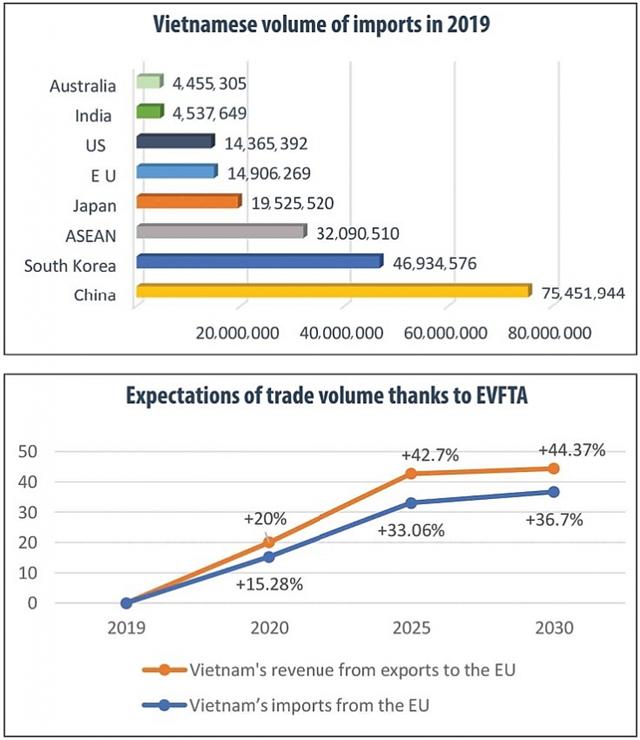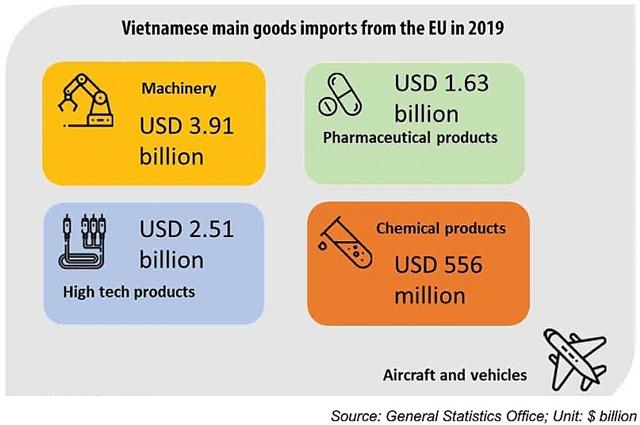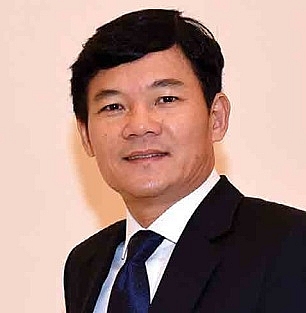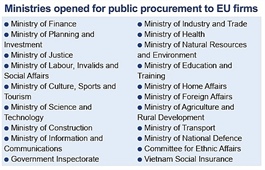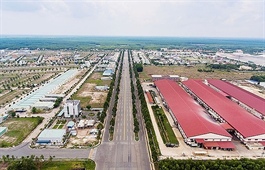Nuts and bolts of Vietnam’s historic trade deal with EU
Nuts and bolts of Vietnam’s historic trade deal with EU
The EU-Vietnam Free Trade Agreement (EVFTA) has come into force from the outset of August. Luong Hoang Thai, director of the Multilateral Trade Policy Department under the Ministry of Industry and Trade talked with VIR’s Phuong Thu about the practical benefits and crucial tasks for the country to maximise the efficiency of the deal.
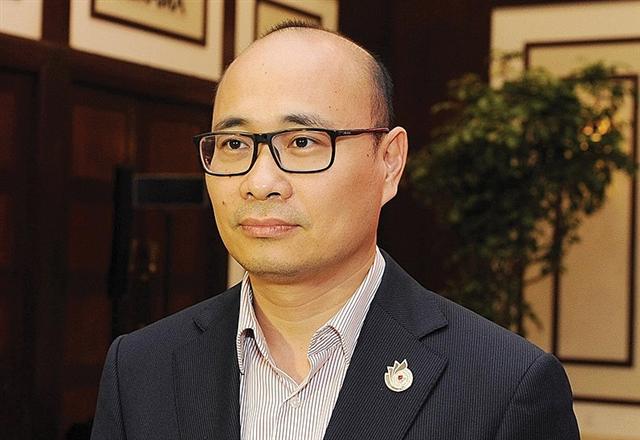
Luong Hoang Thai, director of the Multilateral Trade Policy Department under the Ministry of Industry and Trade
|
What significance does this landmark deal hold for Vietnam, especially with the coronavirus pandemic wreaking havoc on the global economy?
The National Assembly (NA) had ratified the landmark deal on June 8, paving the way for the deal to come into force from August 1.
With the EVFTA’s official enforcement, Vietnamese businesses now have a better chance to approach new supply chains to supersede traditional ones that are either being disrupted or have stalled in the wake of the COVID-19 pandemic. Simultaneously, local businesses have more opportunities to expand and diversify export markets and reduce their reliance on just a small group of markets. This historic deal offers Vietnamese businesses enormous benefits from the reduction and removal of tariff barriers into the EU and its collective GDP of $18 trillion.
Textile and garment, footwear, and seafood are positioned to draw spectacular benefits from the EVFTA, meanwhile the pharmaceutical industry is forecast to see high competitive pressure. How do you think these expectations to play out?
The tariff commitments under the EVFTA are unlikely to entail significant changes for the pharmaceutical industry in the short term, especially compared to the larger import-export picture between the EU and Vietnam. Commitments in other facets of the EVFTA, however, are forecast to have considerable impacts on the market and the performance of local pharmaceutical companies.
Along with this, drugs from the EU will more easily penetrate the Vietnamese market with enhanced intellectual property (IP) protection, which is indeed expected to heat up competition for drug supply tender packages to Vietnamese hospitals. The implications are more evident in regards to brand name and specialised drugs that Vietnam is still unable to produce.
Not only pharmaceutical products, it will not be easy to bring about a breakthrough in agricultural exports either. Will stringent food safety requirements be a problem for Vietnamese produce?
Our experiences from implementing previous FTAs show that these deals can bring tailwind to agricultural and seafood exports. These items, however, cannot reach their full export potential unless the issues about animal and plant quarantine, food safety, and product quality requirements are settled once and for all. To be exported to the EU, local agricultural products must satisfy all requirements on food safety and origin of goods. This includes achieving Global GAP food safety requirements and staying within the maximum residue limit, among others.
|
|
How does Vietnam appear in the eyes of EU importers, and how can the country set itself apart from competition?
Vietnam is a trusted partner, with the requisite capacity and even several advantages to feed the needs of foreign trading partners. While Vietnam is not the only choice for major economies like the United States, the EU, or Japan, it has a fair competitive position.
This is because Vietnam has been steadily reforming its economy and has have the capacity to supply diverse products that are in real demand across the world. Specifically, while many countries have currently restricted the exports of medical equipment due to COVID-19, Vietnam has proved itself as a reliable and steadfast partner to international friends.
Aside from this, the country has scaled up efforts to quickly remove barriers for partners regarding the export of agricultural products or medical instruments. Vietnam is now a big supplier of many items in the global market and in the coming time, along with our traditional strengths in textile and garment, and footwear, Vietnam will do its utmost to boost the production and export of tech items.
What will Vietnam benefit from the EVFTA?
Of the impacts of the agreement on the economies of beneficiary countries, the latest World Bank study highlights the facet of poverty reduction and hunger eradication, as well as the ability of households to reach the middle-income bracket. The study shows that about 800,000 Vietnamese people could escape poverty due to the EVFTA.
In addition, based on a recent study by the Ministry of Planning and Investment, within the next five years, the EVFTA could contribute about 0.5 percentage points to Vietnam’s GDP growth, which outweighs any other FTA Vietnam has ever signed by a fair margin, including the Comprehensive and Progressive Agreement for Trans-Pacific Partnership (CPTPP) that the NA has approved earlier.
To realise this scenario, many issues need to be resolved. Today’s fast-changing global economy has prompted Vietnamese authorities to work out a new approach and adapt to the new situation so shat the country can fully grasp the opportunities new-generation FTAs, particularly the EVFTA, could bring.
What are the key tasks for Vietnam in the upcoming time to ensure the effective enforcement of the EVFTA?
There are four essential tasks. First is penning out a relevant regulatory system. We have gathered valuable experiences from implementing another new-generation FTA, the CPTPP – and we need to use these insights.
Second is the formulation of an action plan on EVFTA implementation. After the EVFTA came into force, the government will issue an action programme on a bigger scale, assigning concrete tasks to ministries, sectors, and localities. The draft of the action programme has already been submitted to the NA.
Third is encouraging the business community to get on board with the EVFTA.
Last but not least is communication activities. The Ministry of Industry and Trade will innovate the way information is accessed, such as by holding online training courses to familiarise people and businesses with the content of the EVFTA and help them identify opportunities. We have received nearly 3,000 applications to register for the courses.
|
Federico Vasoli - Lawyer and managing partner, dMTV Global
The EU-Vietnam Free Trade Agreement (EVFTA) will definitely have a positive impact on the economy and business of Vietnam. Per se, the reduction or elimination of duties makes goods cheaper, hence allowing for greater purchase power and greater margins. Therefore, Vietnam can benefit from a larger inflow of EU products in many fields, including industrial goods, technology, and lifestyle, which will make local companies more competitive and give people access to a wider spectrum of goods at competitive prices. The COVID-19 pandemic has further made purchasing nations realise that they cannot afford to rely solely on one manufacturing hub. Even if a second wave or another similar disaster does not affect the world any time soon, Vietnam is poised to grow as a manufacturing base for local and foreign investors alike. Having many FTAs in place evidently only favours locally-based production, with spillover effects on the entire economy and image of the country. In my many years of legal activity in and with Vietnam, I have always thought that there were too few foreign investments, especially from the EU, which would benefit from the country’s advantages, and would also be to the advantage of Vietnam itself. Colin Blackwell - Founder, Enablecode
First and foremost, the EVFTA gives a welcome economic boost to Vietnam during these challenging times. Any positive news like this will assist in supporting employment levels in the key export sectors. As trade and investment from the EU builds up, so will economic activity and employment opportunities in Vietnam. The other, less well known labour benefits, are the encouragement and technical advice provided during the treaty discussions on modernising the country’s Labour Code. As a result, Vietnam now has one of the most dynamic and positive labour codes in the world, which will benefit sustainable development for many years into the future. This can particularly be seen in labour dispute resolution mechanisms which protect employees and employers alike. Although the EVFTA was one of many factors influencing the new Labour Code, the overall effect really strengthens the way forward for Vietnam’s workforce, given the more complex considerations faced by a middle income country undergoing rapid technology advances. The Labour Code has very future ready provisions on non-discrimination, modern flexible working practices, and the re-skilling needed to remain competitive globally during the Fourth Industrial Revolution. Paul Tonkes - Director, Logistics and industrial services, Cushman & Wakefield
As a member of several international FTAs, Vietnam signed the EVFTA with the EU, in addition to the ASEAN Economic Community. EU duties have dismantling periods stretching from five to seven years of tariff elimination from the existing duty rates of 60.2 per cent to zero. Vietnam agro-fishery, food and beverages, and textile manufacturers are among the largest beneficiaries of this FTA. These companies should prepare to move up the value chain and prepare for the production of high-value products as well as look for new sources of raw materials. In the coming time, focus should be on productivity improvement, digitalisation, and Industry 4.0. Although this is associated with high upfront costs, there is long-term benefit. In that light, tenants should focus on the domestic market, and build and invest time in developing local supply chain quality and find new local clients. Diversifying production could be a shorter-term solution. The current move of the garment and plastic sectors to step into the production of protective gear is pragmatic and a way to offset the loss of orders – although this market is the most volatile, hard to predict, and setting up a factory line takes time. Yanai Hisayuki - CAO Nidec Chaun Choung Vietnam Corporation
The EVFTA is a new generation bilateral agreement which contains fundamental provisions for the cooperation and development of Vietnam’s economy. The agreement will help to strengthen Vietnam’s foreign relationships and open up a new page in the nation’s international economic integration, while further enhancing cooperation on global and regional challenges. To businesses, especially international ones, this agreement helps to bring advanced technologies and opens larger markets to promote and enlarge the development business and meet a wider demand. Our expectation for this event is simply advancing high-quality and sustainable production in Vietnam’s economy, which is truly a significant impact on our long-term business in Vietnam. Since our company is now focusing on strengthening our position in the local market, we have not had a plan to expand the company’s scale to avail such promising opportunity. However, this agreement has brought tremendous opportunities to all enterprises in Vietnam, scaling up economy and social development. Laurent Genet - General director, Audi Vietnam
Germany and Vietnam are now celebrating 45 years of diplomatic relationship and the German Business Association its 25 years in Vietnam. German investment in the country has a long standing history. The 25-story Deutsches Haus opened in 2017 in Ho Chi Minh City and stands as another visible landmark. The EVFTA shall accelerate that investment spread further. For German investors interested in import and retail opportunities, Vietnam’s attractiveness as a market keeps growing with almost 100 million people, a fast-developing middle-class, a massively build-up infrastructure. For German investors looking for a production base, Vietnam is an ideal destination for production investment – thanks to a cost-competitive skilled workforce. Furthermore, the impact of COVID-19 highlighted the need to prevent supply chain disruptions by diversifying suppliers and avoiding reliance on one single country like China. German investors interested in export will consider Vietnam’s unique trade capacity in Southeast Asia with its record number of 14 FTAs signed. Nguyen Thi Tra My - CEO, The PAN Group
The EVFTA opens huge opportunities for Vietnam in its key sectors like agriculture, fishery, and processed food, which are also The PAN Group’s core businesses. In addition to the roadmap of tariff cuts, many export items to the EU will have their quotas increased. For example, right after the enforcement of the landmark agreement, the EU gives Vietnam an export quota of 80,000 tonnes of rice a year with tariff of zero per cent. To enjoy this tariff cut, Vietnamese businesses need to meet a lot of strict requirements to overcome the on-tariff barriers on goods’ quality, the origins, food safety and hygiene, and environmental factors, among others. To tap into the opportunities from the EVFTA, The PAN Group has made preparations for a long time to satisfy the requirements and to conquer the market with high-quality products. For example, we put into operation the Vinarice factory with modern assembly lines in late 2019. In July, a member of The PAN Group successfully exported VJ Pearl Rice and RVT fragrant rice to the Netherlands and the Czech Republic. Tran Nhu Tung - Deputy general director, Thanh Cong Text Garment JSC
As the EVFTA officially took effect on August 1, we now expect to grow our exports to the EU by 30-50 per cent in the coming years. To materialise the agreement’s opportunities, Thanh Cong built up a garment-dyeing factory with 1,500 labourers in Hoa Phu Industrial Zone in the Mekong Delta province of Vinh Long. Its estimated annual output is expected to meet the trade demand of the company. Moreover, to accelerate the expansion to the EU’s market, Thanh Cong plans to open a similar factory in the southwest of the country. However, developing garment factories was found burdensome in recent times because of the concerns of environmental pollution. Therefore, the local government should soon take prompt actions to help garment companies enhance their productivity to take advantages of the agreement. C.K Tong - CEO, BW Industrial Development JSC
The EVFTA has definitely impacted us positively, bringing us a lot of enquiries, and we have recently signed deals with some European-based manufacturers. In Vietnam, BW Industrial Development JSC is one of the very few developers with ready-to-move-in factories at strategic locations, and we are well-positioned to avail of the advantage. We are planning and doing a lot of activities right now, including organising and taking part in webinars, talking to related associations and business groups, working with agents locally and internationally, and making sure that we reach the categories of this group of clients, whether they are in China, in Europe, or in any other part of the world. As the pandemic is evolving, we also offer virtual tours, road shows, and some other digital solutions that help us approach investors who cannot be here. Bui Ha Linh - Economic researcher and project manager, Friedrich Naumann Foundation Vietnam
The EVFTA offers many opportunities to build and develop a digital economy in Vietnam. The most direct way is through increasing the trading of high-tech goods and attracting investment in technology-related projects. Europe is our long-standing trade partner, with a high level of technology development under the lead of Germany – a pioneer in Fourth Industrial Revolution. A solid trade partnership could encourage technology transfers from the EU, and at the same time, set a foundation for creativity and innovation. However, the EVFTA impacts less on some key pillars of the digital economy, such as telecommunications and its infrastructure. The worries for cybersecurity constraint openness for this sector in the EVFTA, but it is reasonable and also the typical concern in many nations. |


